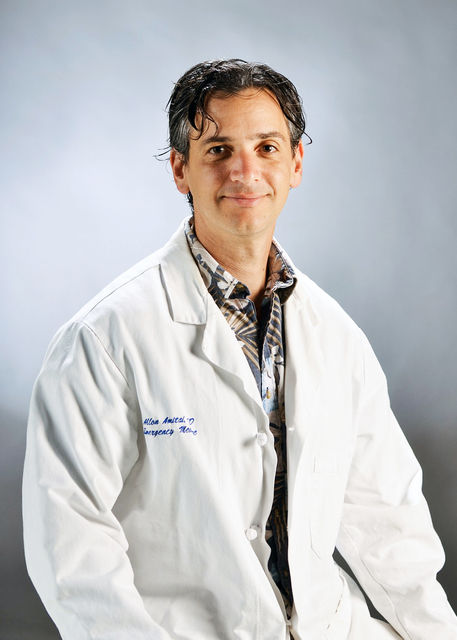Dr. Allon Amitai can see up to 20 patients a night at the Wilcox Memorial Hospital Emergency Room, and it’s never a dull moment. From drug overdoses to tourists with sprained ankles, Amitai is prepared to handle it all. After
Dr. Allon Amitai can see up to 20 patients a night at the Wilcox Memorial Hospital Emergency Room, and it’s never a dull moment. From drug overdoses to tourists with sprained ankles, Amitai is prepared to handle it all.
After graduating from the University of CaliforniaBerkeley, Amitai obtained his medical degree at the Tel Aviv University Sackler School of Medicine in Israel and completed his emergency medicine residency at SUNY Downstate/Kings County Hospital in Brooklyn, New York. He then completed his fellowship training in internal emergency medicine at the Brown University Rhode Island Hospital in Providence, Rhode Island.
Although the job can stressful, the ER doctor successfully gets through the night with the help of his staff, one patient at a time. Afterwards, he kicks back with his world-famous pig Lilikoi and surfs the waves of Kauai.
Why did you want to be a doctor?
As a kid, I loved science, but as I grew older, I became more interested in anthropology and the study of humanity in all its diversity — in different languages, cultures and ways of thinking and living. Medicine allowed me to combine my interests in science with helping people. As a physician on Kauai, I get to meet and treat people from all over the world and from the many cultures that live on this island.
Why did you move to Hawaii?
I moved to Honolulu with my parents and sister when I was 2 years old. My mother was doing her medical residency in pathology at Kuakini Hospital. Hawaii is great for small children, and I still have vivid memories of exploring Hanauma Bay, Bellows Beach and Windward Oahu as a kid. After going to school on the Mainland and training in emergency medicine in the freezing Northeast, I wanted to come back. This is the most beautiful place to live in the world, and nowhere else has the wonderful mix of cultures we have on these islands.
Where did you move from?
I trained in emergency medicine at Kings County Hospital in Brooklyn, New York. This is a massive hospital that sees more than 125,000 inner-city patients a year and leads the country in treating gunshot wounds and stabbings. After finishing my emergency medicine residency and fellowship training, I lived on Oahu for six years and worked at several emergency departments at a few different Oahu hospitals. Oahu is a lovely island in many respects, and Honolulu is an entertaining city with a lot going on, but the traffic and crowds were a bit much for me. I was very happy when I learned of the opening at Wilcox.
Can you please describe what you do as an emergency physician? What are your responsibilities?
I am a specialist in emergency medicine, which means I am the first doctor you see when you arrive at the Emergency Department seeking medical attention. I mostly work nights, so it’s often just me and an internal medicine physician in the hospital, along with a team of nurses, a respiratory therapist, an X-ray technician and other support personnel. I have to be able to independently assess and stabilize all kinds of immediate medical problems for patients of all ages and all medical specialties. I see everyone who walks in the door or is wheeled in by ambulance — from newborns with fevers, to women in labor, to victims of drug overdoses and drownings. Once patients are stabilized, I then decide if they can be discharged to their home or if they should be admitted to the hospital. We have an amazing amount of resources available on Kauai for such a small population, but there are some things we just can’t do that require transfer — for example, brain surgery, heart surgery or psychiatric hospitalization.
Describe the patients you would see in any given night.
In a typical eight-hour shift, I’ll usually see 15-20 patients, but the total number of people who come in through the door can’t be predicted. In a typical shift, I can reasonably expect to treat anyone of any age for fever, abdominal pain, headache, food poisoning or stomach flu, chest pain or difficulty breathing, a sprained ankle or knee, and so on. There’s also a good chance I’ll treat a car accident victim and assess someone with out-of-control anxiety, suicidal thoughts or hallucinations. I also will see several tourists, many of whom travel here with complicated medical problems.
I hear you have a world-famous pig named Lilikoi. Tell me about her.
Lilikoi is a mini-Juliana pig weighing in at about 60 pounds and is a little more than a year old. She’s my main source of comic relief after a rough night shift. She’s highly intelligent and loves to go hiking and paddleboarding. She can open doors, drink from bottles and hide under blankets. She likes to go up to strangers on the beach and beg them for beer. She’s achieved some global fame, and there have been articles written about her lifestyle in Germany, Sweden, Korea and as far off as Azerbaijan. It’s humbling to realize that your pig is more famous and popular than you will ever be.
What do you do for fun?
Kauai is a great island for fun outside of work. The hiking, paddling, diving and surfing here are world-class. It’s also a perfect place for gardening. I also enjoy traveling off-island on medical relief and stabilization missions. In recent years, I’ve taken care of patients in the Philippines, Mongolia, Ukraine, Chile and Abu Dhabi. Traveling off-island is a great way to remember how wonderful Kauai is.


